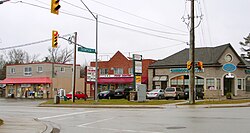History
In 1793, Governor John Graves Simcoe came across what would be the future site of Holland Landing, then known as St. Albans. He believed the area would make an ideal portage route and defence point between York (now Toronto) and Georgian Bay. [2] Holland Landing was named after Samuel Holland, first Surveyor-General of British North America, who had served on HMS Pembroke, under Captain John Simcoe, father of Governor Simcoe, for whom Lake Simcoe is named.
Holland Landing was the northernmost point on the original alignment of Yonge Street. North of the town the Holland River is easily navigable, and the location was selected as a well sited inland port for Lake Simcoe, via the river. It was intended that Yonge Street, in combination with the similar Penetanguishene Road further north, would provide access to the upper Great Lakes from the city of York. Holland Landing would be a major point on this route.
However, it never served this intended role in any real capacity. The closest it came was during the War of 1812, when the British decided to retake the entire lake system through the construction of a number of first-rate ships in Kingston and Penetanguishene. A large anchor, over fifteen feet (roughly 4.6 m) long and weighing approximately 4000 lbs (about 1 816 kg), for the frigate under construction at Penetanguishene was shipped from England and had made it as far as Holland Landing when the war ended. It was abandoned and is currently on display at Anchor Park. [3] From approximately 1833-1853, Holland Landing was a destination for steamboats carrying freight and passengers along the west branch of the Holland River. By 1845, Holland Landing had a brewery, a distillery, and multiple taverns patronized by locals and visitors from the waterway. [4]
The town itself was not formed until the early 19th century, settled by the same Quaker immigrants as nearby Newmarket and Aurora. In 1815, a population of settlers from Selkirk, Manitoba arrived in Holland Landing after a conflict between them and the Métis. [5]
Samuel Lount, a martyr of the 1837 Rebellion led by William Lyon Mackenzie, farmed and operated a smithy here. Lount was captured later, convicted of treason, and hanged on April 12, 1838. [6]
The idea for a canal linking to Lake Simcoe and the Trent-Severn Waterway was approved and construction started in 1906. Holland Landing would connect Newmarket and Bradford. It was almost complete in the summer of 1912 – three lift locks, three swing bridges and a turning basin – when the new government of Robert Borden cancelled the project. The project was abandoned, earning it the name "The Ghost Canal". [7] It continues to serve as a historical landmark.
This page is based on this
Wikipedia article Text is available under the
CC BY-SA 4.0 license; additional terms may apply.
Images, videos and audio are available under their respective licenses.


